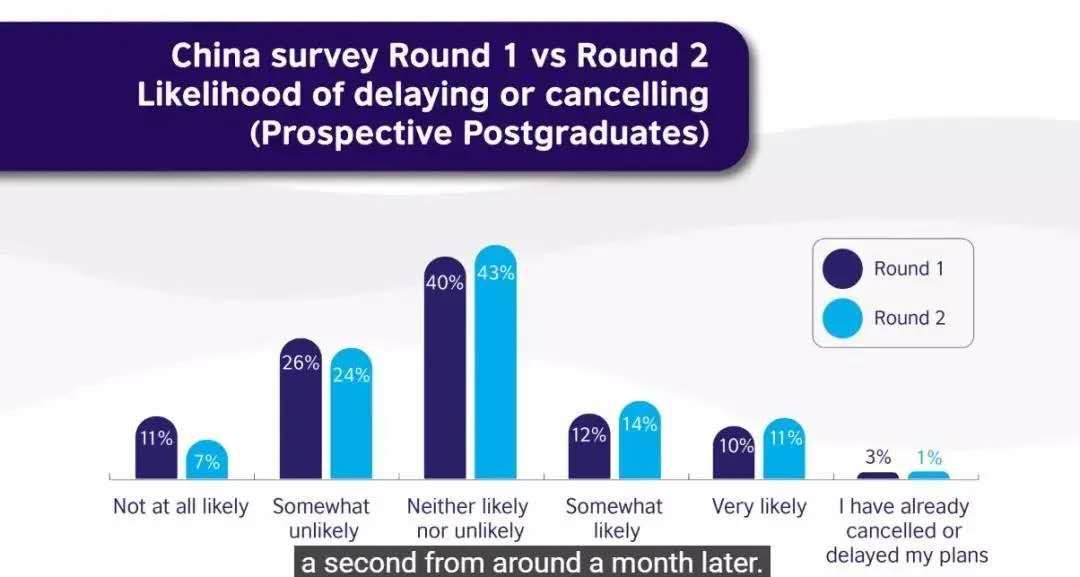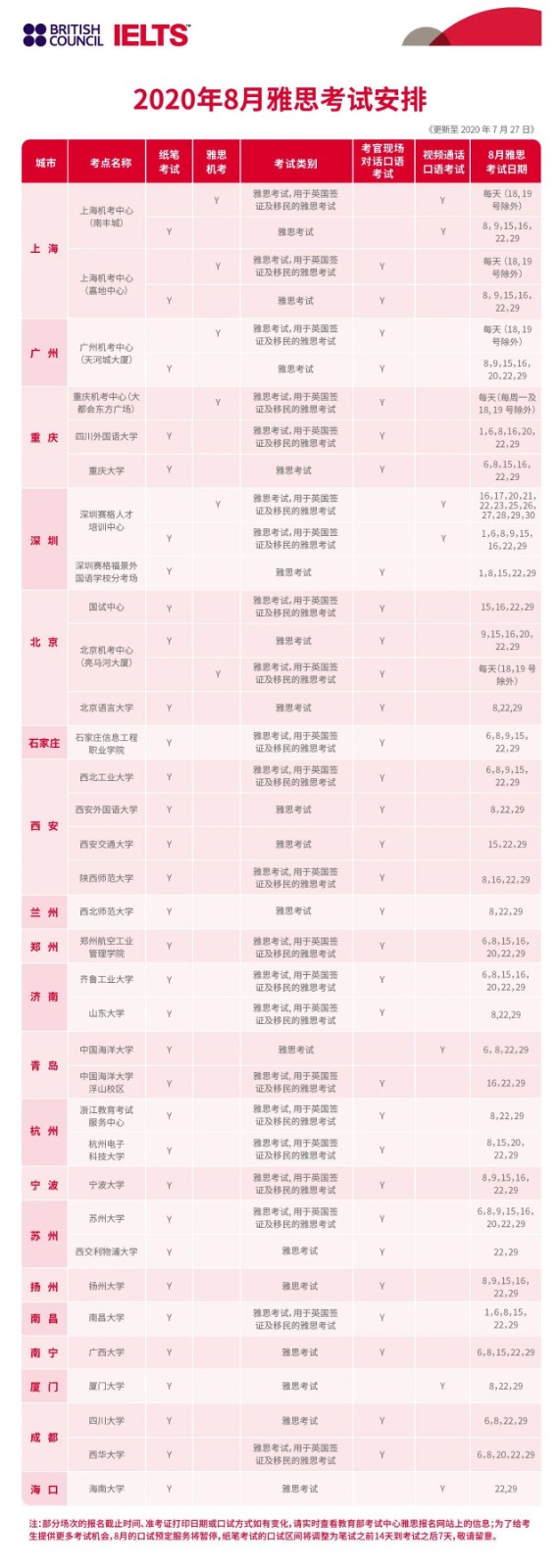报考雅思 ,考试指南了解一下,今天小编给大家带来报考雅思考试指南,希望能够帮助到大家,下面小编就和大家分享,来欣赏一下吧。
报考雅思 考试指南了解一下
雅思考试(IELTS - International English Language Testing System 国际英语语言测试系统)是听说读写四项英语交流能力的测试。
雅思考试由英国文化协会、剑桥大学考试委员会外语考试部和IDP教育集团三方在全球共同组织运作。雅思考试是一种较全面地针对听说读写四项能力的、为打算到英语国家学习、工作或定居的人们设置的英语水平考试。
每年,全球共有超过200万的考生在135个国家和地区参加雅思考试。雅思考试已经成为全球留学移民类英语测评的领导者。
全球超过8,000所院校机构所认可。无论你想留学、移民、就业,还是检测英语水平,无论你想去英国、美国、加拿大、美国、新西兰,还是荷兰、法国、德国、新加坡、香港等,你只需要一项英语考试—雅思考试。
雅思考试兼具实用性和学术性,能够精准地测评考生真实的英语沟通能力。 雅思分学术类(A类)和普通类(G类)两种题型,学术类主要适合留学,普通类主要适合移民。
针对赴英国读书的同学,英国大使馆推出用于英国签证及移民的雅思考试。雅思产生听说读写四个单项分数,单项的满分是9分(精通英语),其次是8分 (优秀英语),7分(良好英语),6分(掌握英语),5分(勉强掌握),4分(有限英语),3分(少量英语),2分(少量单词),1分(不懂英语),0分 (没有考试)。
雅思考试包括四个部分,依次为听力、阅读、写作和口语,考试时间共2小时45分钟。每一部分都独立评分,四部分得分的平均分作为考生的雅思综合得分(小数部分取舍到最近的一分或半分,即如果平均分为6.125分,雅思得分算作6分)。成绩单上将列出考生每一部分的得分,同时给出考生的综合得分。雅思考试满分为9分。考试成绩在考试后十个工作日后通知考生。雅思考试成绩有效期为两年。
通常经验,一名有中级英语基础的考生通过有关IELTS参考书籍学习或考前复习培训班,二三个月后可参加本考试。
对中国考生来说,IELTS考试的词汇要求并不高,主要偏向生活化,但答题技巧和英国传统题型,因与TOEFL和国内英语考试(4-6级)完全不同,所以掌握题型和快速解答就显得非常重要。
考试分4个部分,一般需要两天时间举行。第一天的上午,全体考生都要参加相继进行的听力、阅读、写作三项考试;口语考试通常需要另行一天安排。许多人都觉得一般外地考生会被优先安排在第一天下午,实际上这种观念是错误的,口语考试的安排是随机的,和本地外地考生无关。
雅思阅读全真练习系列:The Triumph of Unreason
The Triumph of Unreason?
A. Neoclassical economics is built on the assumption that humans are rational beings who have a clear idea of their best interests and strive to extract maximum benefit (or “utility”, in economist-speak) from any situation. Neoclassical economics assumes that the process of decision-making is rational. But that contradicts growing evidence that decision-making draws on the emotions—even when reason is clearly involved.
B. The role of emotions in decisions makes perfect sense. For situations met frequently in the past, such as obtaining food and mates, and confronting or fleeing from threats, the neural mechanisms required to weigh up the pros and cons will have been honed by evolution to produce an optimal outcome. Since emotion is the mechanism by which animals are prodded towards such outcomes, evolutionary and economic theory predict the same practical consequences for utility in these cases. But does this still apply when the ancestral machinery has to respond to the stimuli of urban modernity?
C. One of the people who thinks that it does not is George Loewenstein, an economist at Carnegie Mellon University, in Pittsburgh. In particular, he suspects that modern shopping has subverted the decision-making machinery in a way that encourages people to run up debt. To prove the point he has teamed up with two psychologists, Brian Knutson of Stanford University and Drazen Prelec of the Massachusetts Institute of Technology, to look at what happens in the brain when it is deciding what to buy.
D. In a study, the three researchers asked 26 volunteers to decide whether to buy a series of products such as a box of chocolates or a DVD of the television show that were flashed on a computer screen one after another. In each round of the task, the researchers first presented the product and then its price, with each step lasting four seconds. In the final stage, which also lasted four seconds, they asked the volunteers to make up their minds. While the volunteers were taking part in the experiment, the researchers scanned their brains using a technique called functional magnetic resonance imaging (fMRI). This measures blood flow and oxygen consumption in the brain, as an indication of its activity.
E. The researchers found that different parts of the brain were involved at different stages of the test. The nucleus accumbens was the most active part when a product was being displayed. Moreover, the level of its activity correlated with the reported desirability of the product in question.
F. When the price appeared, however, fMRI reported more activity in other parts of the brain. Excessively high prices increased activity in the insular cortex, a brain region linked to expectations of pain, monetary loss and the viewing of upsetting pictures. The researchers also found greater activity in this region of the brain when the subject decided not to purchase an item.
G. Price information activated the medial prefrontal cortex, too. This part of the brain is involved in rational calculation. In the experiment its activity seemed to correlate with a volunteer's reaction to both product and price, rather than to price alone. Thus, the sense of a good bargain evoked higher activity levels in the medial prefrontal cortex, and this often preceded a decision to buy.
H. People's shopping behaviour therefore seems to have piggy-backed on old neural circuits evolved for anticipation of reward and the avoidance of hazards. What Dr Loewenstein found interesting was the separation of the assessment of the product (which seems to be associated with the nucleus accumbens) from the assessment of its price (associated with the insular cortex), even though the two are then synthesised in the prefrontal cortex. His hypothesis is that rather than weighing the present good against future alternatives, as orthodox economics suggests happens, people actually balance the immediate pleasure of the prospective possession of a product with the immediate pain of paying for it.
I. That makes perfect sense as an evolved mechanism for trading. If one useful object is being traded for another (hard cash in modern time), the future utility of what is being given up is embedded in the object being traded. Emotion is as capable of assigning such a value as reason. Buying on credit, though, may be different. The abstract nature of credit cards, coupled with the deferment of payment that they promise, may modulate the “con” side of the calculation in favour of the “pro”.
J. Whether it actually does so will be the subject of further experiments that the three researchers are now designing. These will test whether people with distinctly different spending behaviour, such as miserliness and extravagance, experience different amounts of pain in response to prices. They will also assess whether, in the same individuals, buying with credit cards eases the pain compared with paying by cash. If they find that it does, then credit cards may have to join the list of things such as fatty and sugary foods, and recreational drugs, that subvert human instincts in ways that seem pleasurable at the time but can have a long and malign aftertaste.
Questions 1-6 Do the following statemets reflect the claims of the writer in Reading Passage 1?
Write your answer in Boxes 1-6 on your answer sheet.
TRUE if the statement reflets the claims of the writer
FALSE if the statement contradicts the claims of the writer
NOT GIVEN if it is possbile to say what the writer thinks about this
1. The belief of neoclassical economics does not accord with the increasing evidence that humans make use of the emotions to make decisions.
2. Animals are urged by emotion to strive for an optimal outcomes or extract maximum utility from any situation.
3. George Loewenstein thinks that modern ways of shopping tend to allow people to accumulate their debts.
4. The more active the nucleus accumens was, the stronger the desire of people for the product in question became.
5. The prefrontal cortex of the human brain is linked to monetary loss and the viewing of upsetting pictures.
6. When the activity in nucleus accumbens was increased by the sense of a good bargain, people tended to purchase coffee.
Questions 7-9 Choose the appropriate letters A-D and write them in boxes 7-9 on your answe sheet.
7. Which of the following statements about orthodox economics is true?
A. The process which people make their decisions is rational.
B. People have a clear idea of their best interests in any situation.
C. Humans make judgement on the basis of reason rather then emotion.
D. People weigh the present good against future alternatives in shopping.
8. The word “miserliness” in line 3 of Paragraph J means__________.
A. people’s behavior of buying luxurious goods
B. people’s behavior of buying very special items
C. people’s behavior of being very mean in shopping
D. people’s behavior of being very generous in shopping
9. The three researchers are now designing the future experiments, which test
A. whether people with very different spending behaviour experience different amounts of pain in response to products.
B. whether buying an item with credit cards eases the pain of the same individuals compared with paying for it by cash.
C. whether the abstract nature of credit cards may modulate the “con” side of the calculation in favour of the “pro”.
D. whether the credit cards may subvert human instincts in ways that seem pleasurable but with a terrible effect.
Questions 10-13 Complete the notes below.
Choose NO MORE THAN THREE WORDS from Reading Passage 1 for each answer.
Write your answers in boxes 10-13 on your answer sheet.
To find what happens in the brain of humans when it is deciding things to buy, George Loewenstein and his co-researchers did an experiment by using the technique of fMRI. They found that different parts of the brain were invloved in the process. The activity in …10… was greatly increased with the displaying of certain product. The great activity was found in the insular cortex when …11…and the subject decided not to buy a product. The activity of the medial prefrontal cortex seemed to associate with both …12…informaiton. What interested Dr Loewenstein was the …13… of the assessment of the product and its price in different parts of the brain.
答案:TTFTF
报考雅思考试指南了解一下相关文章:









 扫一扫支付
扫一扫支付


